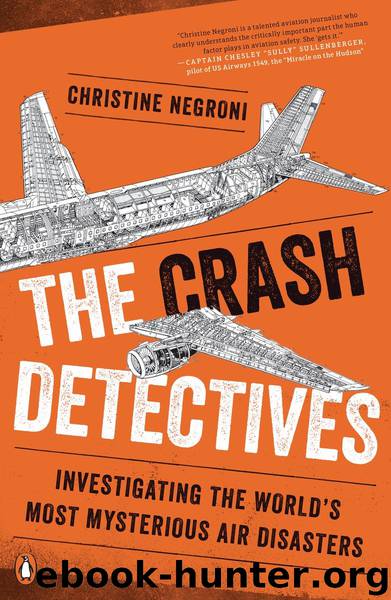The Crash Detectives by Christine Negroni

Author:Christine Negroni
Language: eng
Format: epub
Publisher: Penguin Publishing Group
Published: 2016-09-12T15:14:29+00:00
Deflection
The single aisle Boeing 737, introduced in 1968, is Boeing’s best-selling airliner and has flown in nine different versions. On March 3, 1991, a United Airlines 737 crashed preparing to land in Colorado Springs, killing all twenty-five people aboard. It had been an uneventful flight until just after 9:43 a.m. Flight 585 was on approach, and First Officer Patricia Eidson was concerned about the turbulence experienced by the plane that had landed ahead of them.
“I’ll watch that airspeed gauge like it’s my mom’s last minute,” Eidson said to Capt. Hal Green. Indeed, the descent was dodgy, with the plane accelerating and Green complaining how hard it was to hold his airspeed.
“Wow,” Eidson said, followed twenty seconds later by “We’re at a thousand feet.” The plane rolled to the right, and the pilots tried to regain control. The cockpit voice recorder suggests the captain was adjusting settings for a go-around, abandoning the present landing to go around and try again. The only communication between the pilots makes it clear they realized the plane was going to crash. “Oh God,” the first officer says repeatedly. “Oh no,” Green says the second before impact.
Investigators thought early on that the rudder, the hinged vertical panel on the tail that swings from side to side to control the plane’s left and right motion, played a role. The week before the accident, two crews who flew the plane reported problems related to the operation of the rudder, including uncommanded movement. In July 1992, as the investigation was under way, a United maintenance worker reported finding an anomaly during a ground check of another 737 in the fleet. “The rudder had the potential to operate in a direction opposite to that commanded by the flight crew,” the airline reported. The main rudder control valve was changed by Parker Hannifin, the company that designed it.*
Still, after nearly two years studying the evidence, Tom Haueter, the NTSB investigator in charge, could not say conclusively if or how the rudder factored in. The probable cause of the accident was left as one of two likely events: some mechanical problem with lateral control of the aircraft, or an atmospheric disturbance that caused the airplane to enter an uncontrollable roll. From that point on, though, Haueter took notice of any difficulties reported with the 737’s rudder.
Among the family of Boeing airplanes, the 737’s rudder design was unique in a number of ways. First, since it was smaller than the 727 and the 747, there was not enough room for two entirely separate and redundant power control units. That unit, known by the abbreviation PCU, takes the input of the pilot’s foot on the rudder pedal and converts it through hydraulic action into movement of the swinging panel on the tail.
Boeing got the plane certified with a novel design that put both control of the rudder and a backup in the same unit. In what was to be a belt-and-suspenders plan, Boeing told the FAA that in the unlikely case of a loss
Download
This site does not store any files on its server. We only index and link to content provided by other sites. Please contact the content providers to delete copyright contents if any and email us, we'll remove relevant links or contents immediately.
| Airport | Commercial |
| Helicopters | History |
| Pictorial | Piloting & Flight Instruction |
| Repair & Maintenance |
Small Unmanned Fixed-wing Aircraft Design by Andrew J. Keane Andras Sobester James P. Scanlan & András Sóbester & James P. Scanlan(32141)
Navigation and Map Reading by K Andrew(4554)
Endurance: Shackleton's Incredible Voyage by Alfred Lansing(3845)
Wild Ride by Adam Lashinsky(1659)
And the Band Played On by Randy Shilts(1615)
The Box by Marc Levinson(1596)
Top 10 Prague (EYEWITNESS TOP 10 TRAVEL GUIDES) by DK(1568)
The Race for Hitler's X-Planes: Britain's 1945 Mission to Capture Secret Luftwaffe Technology by John Christopher(1526)
The One Percenter Encyclopedia by Bill Hayes(1463)
Girls Auto Clinic Glove Box Guide by Patrice Banks(1363)
Trans-Siberian Railway by Lonely Planet(1345)
Looking for a Ship by John McPhee(1320)
Batavia's Graveyard by Mike Dash(1302)
Fighting Hitler's Jets: The Extraordinary Story of the American Airmen Who Beat the Luftwaffe and Defeated Nazi Germany by Robert F. Dorr(1301)
Troubleshooting and Repair of Diesel Engines by Paul Dempsey(1284)
Bligh by Rob Mundle(1274)
TWA 800 by Jack Cashill(1253)
The Great Halifax Explosion by John U. Bacon(1229)
Ticket to Ride by Tom Chesshyre(1229)
